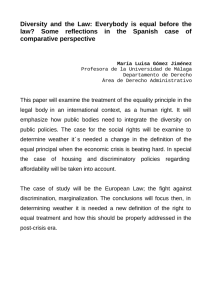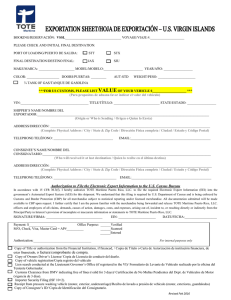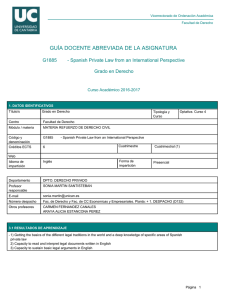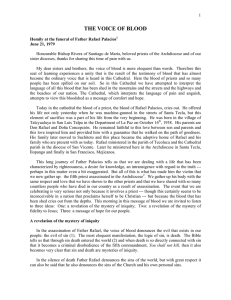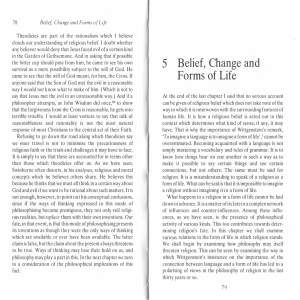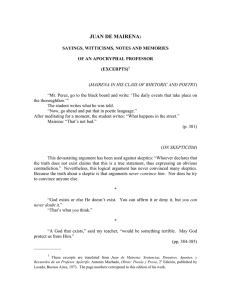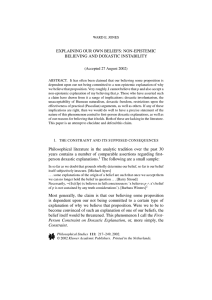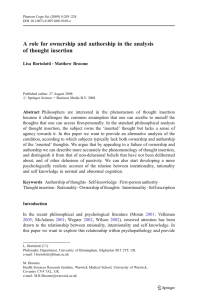It is a common concern of Western civilization legal systems
Anuncio
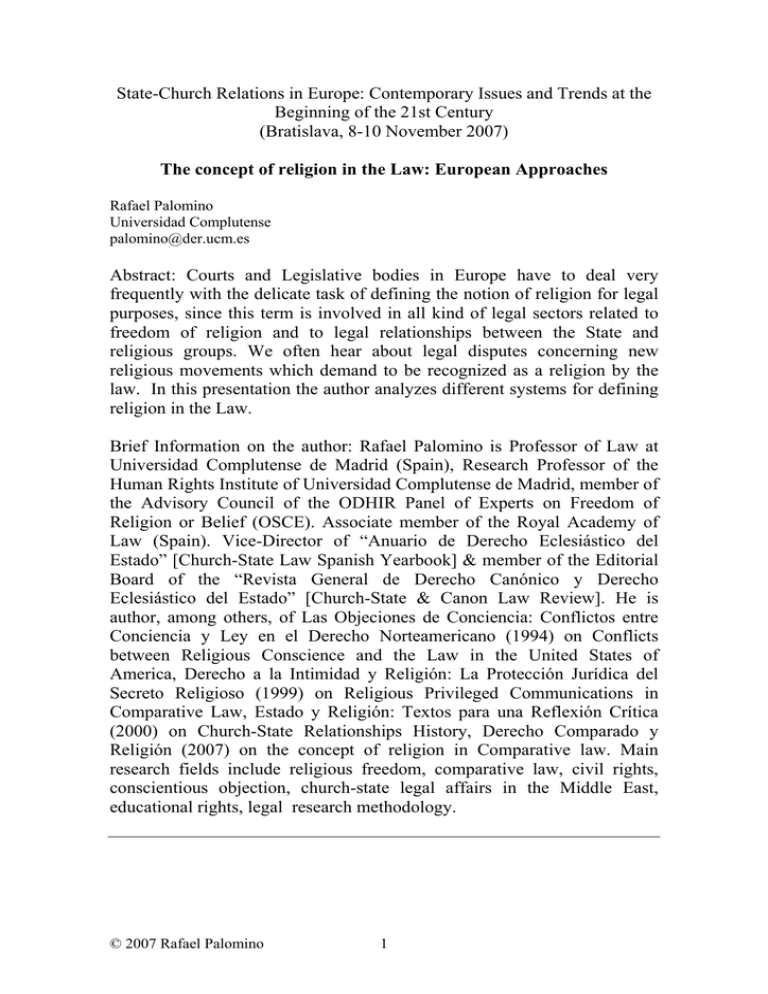
State-Church Relations in Europe: Contemporary Issues and Trends at the Beginning of the 21st Century (Bratislava, 8-10 November 2007) The concept of religion in the Law: European Approaches Rafael Palomino Universidad Complutense palomino@der.ucm.es Abstract: Courts and Legislative bodies in Europe have to deal very frequently with the delicate task of defining the notion of religion for legal purposes, since this term is involved in all kind of legal sectors related to freedom of religion and to legal relationships between the State and religious groups. We often hear about legal disputes concerning new religious movements which demand to be recognized as a religion by the law. In this presentation the author analyzes different systems for defining religion in the Law. Brief Information on the author: Rafael Palomino is Professor of Law at Universidad Complutense de Madrid (Spain), Research Professor of the Human Rights Institute of Universidad Complutense de Madrid, member of the Advisory Council of the ODHIR Panel of Experts on Freedom of Religion or Belief (OSCE). Associate member of the Royal Academy of Law (Spain). Vice-Director of “Anuario de Derecho Eclesiástico del Estado” [Church-State Law Spanish Yearbook] & member of the Editorial Board of the “Revista General de Derecho Canónico y Derecho Eclesiástico del Estado” [Church-State & Canon Law Review]. He is author, among others, of Las Objeciones de Conciencia: Conflictos entre Conciencia y Ley en el Derecho Norteamericano (1994) on Conflicts between Religious Conscience and the Law in the United States of America, Derecho a la Intimidad y Religión: La Protección Jurídica del Secreto Religioso (1999) on Religious Privileged Communications in Comparative Law, Estado y Religión: Textos para una Reflexión Crítica (2000) on Church-State Relationships History, Derecho Comparado y Religión (2007) on the concept of religion in Comparative law. Main research fields include religious freedom, comparative law, civil rights, conscientious objection, church-state legal affairs in the Middle East, educational rights, legal research methodology. © 2007 Rafael Palomino 1 1. Introduction. There is concern in many legal systems over the meaning of the term “religion” which the law contains. This concern is manifested in those borderline cases in which new religious movements come to the law seeking legal recognition as religious communities or groups. It is also apparent in cases in which a group or association seeks a legal status (a taxexempt status) which is specifically confined to religious institutions in particular or to non-profit organizations in general. In recent times many States have enacted special laws to bestow or recognized the legal personality of religious groups in countries with a strong tradition attached to a certain religious denomination or in countries in which religious freedom has been recognized very recently. Usually, these special laws make explicit or implicit references to conditions to gain the status of religious community, which are not specifically linked to a religion, but to other issues, such as time of implementation, number of members, statutes or regulations content, etc. 1 An important sector of the academy feels that according to the very nature of religious freedom it is unlawful to craft any kind of definition or concept of religion. According to this trend the law has nothing to do with religion and its only task is to protect religious freedom. Any person or any group who assert any kind of injure on religious freedom grounds deserves protection or at least attention. The question then is not if the group or the individual is religious, but the factual aspects of the specific case, under which the law affords protection to the individual. Being that true, to other scholars the question still remains. Although the State has neither the skills nor the competence to define what is religion for legal purposes, it is clear that the word “religion” or the word “beliefs” appear in legal text and probably would be necessary to proceed with this concept the same way as with any other word of the same category, like “art,” “culture,” “sport,” “literature” and so forth. In this presentation I shall sketch the basic reasons according to which the term religion is relevant to the law and to sketch different tendencies to formulate the concept of religion in the law. 1 See Case of the Moscow Branch of the Salvation Army v. Russia (Application no. 72881/01); Case of Church of Scientology Moscow v. Russia (Application no. 18147/02). © 2007 Rafael Palomino 2 2. Why the concept of religion matters? There are at least three different ways to answer this question affirmatively. Each of them is grounded in practical, not theoretical, issues. 2.1. Social activity and religion. The first point deals with the distinction made between different segments of activity in civil society before the law. Among others, these segments are financial enterprises, non-profit sector, culture and arts, the beliefs and religious sector. Each of them might be combined with another one, but at the same time it seems to be clear that each of them has its own consistency and merits attention by and to itself. That is why, for instance, welfare state promotes and protects indigenous arts and culture, regulates as a special sector sports played by citizens or endorse the improvement of the industrial tissue of the country. In the case of religion, the state of affairs is somewhat different. Since democratic states recognize religious freedom and some sort of separation of Church and State, governments avoid the identification or entanglement with religion in different degrees. And at the same time, when religion enters into contact with other segments of activity (religion with politics or religion with economics) probably the Law will react in a strong way to return each activity to their own sector. This is the case of the religious association Kalifatstaat in Germany, in the year 2003, which was decided by the German Constitutional Court 2 . A similar case was decided by the European Court of Human Rights in Refah Partisi v. Turkey 3 . It is true that in both the cases it is important to take into account other issue, namely the danger posed to democracy by a political vision of Islam. But the subtle message of separating politics from religion, at least in an explicit way, still remains. And it is even clearer in those cases in which economics and 2 A. SEGLERS GÓMEZ-QUINTERO (con la colaboración de J.M. MARTINELL), La laicidad y sus matices, Comares, Granada (2005), pp. 65-67. 3 Refah Partisi (The Welfare Party) and Others v. Turkey 41340/98;41342/98;41343/98;... [2003] ECHR 87 (13 February 2003), n. 30. © 2007 Rafael Palomino 3 religion interact in the same community or group, as in Germany 4 , Italy 5 or France 6 . 2.2. Religion mentioned in legal texts. In connection with the first point explained above, the constitutional and fundamental texts of many countries make explicit reference or take into consideration religion in order to maintain some kind of special relationship. This explicit mention of religion could be seen clearly in the Constitution of Poland, article 25 § (3) The relationship between the State and churches and other religious organizations shall be based on the principle of respect for their autonomy and the mutual independence of each in its own sphere, as well as on the principle of cooperation for the individual and the common good7 . It is also the case in the Spanish Constitution, article 16 § 3 No religion shall have a state character. The public powers shall take into account the religious beliefs of Spanish society and maintain the appropriate relations of cooperation, with the Catholic Church and other denominations. With different wording, this is also the case of the Italian Constitution of 1947 which points out in article 8: The relations with the State are regulated by law on the basis of agreements with their respective representatives. Or other example, the case of Germany in the Weimar Constitution article 137 annexed 8 . 4 F. MESSNER, «Peut-on définir juridiquement la religion? L´exemple de la Republique Fédérale d´Allemagne», L´année canonique, vol. 31 (1988), pp. 336-342. 5 Among others, M. FORMICA, «L'art. 416 c.p. e le confessioni religiose: un commento all'epilogo del "caso Scientology" (Nota a App. Milano 5 ottobre 2000)», Il Foro Italiano, 126 (12) 2001, p. 644-3450; R. SARACINO, «Scientology tra libertà religiosa e diritto comune», Il Diritto Eclesiastico, n. 2 (2001), p. 112. 6 F. ONIDA, «Nuove problematiche religiose per gli ordinamenti laici contemporanei: il caso Scientology», Quaderni di Diritto e Politica Eclesiastica, 1997/3, pp. 992-993. 7 The text of this Constitution and of the Constitutions mentioned above are compiled in A.M. VEGA GUTIÉRREZ (coord.), Religión y libertades fundamentales en los países de Naciones Unidas: textos constitucionales, Comares, Granada (2003). 8 Article 137. (Weimar Constitution). 1.There is no state church. 2. Freedom of association is guaranteed to religious bodies. There are no restrictions as to the union of religious bodies within the territory of the Federation. 3. Each religious body regulates and administers its affairs independently within the limits of general laws. It appoints its officials without the cooperation of the Land, or of the civil community. 4. Religious bodies acquire legal rights in accordance with the general regulations of the civil code. 5. Religious bodies remain corporations with public rights in so far as they have been so up to the present. Equal rights shall be granted to other religious bodies upon application, if their constitution and the number of their members offer a guarantee of © 2007 Rafael Palomino 4 In other cases, religion (sometimes coupled with the term belief) appears in the constitutional texts qualifying a specific freedom: freedom of religion. This is the case, for instance, of the Slovak Republic in article 24 of the Constitution of 1992: The freedoms of thought, conscience, religion, and faith are guaranteed. This right also comprises the possibility to change one’s religion, belief or faith. Everyone has the right to be without religious belief. Everyone has the right to publicly express his opinion. Hence, in many cases the law has to explore the meaning of religion, what is belief or faith, in narrow or broad terms, for citizens or persons as individuals or for groups and communities. This could be relevant, for instance, in order to determine whether some grounds for discrimination are accomplished or even if there are factual basis for asylum-case adjudication 9 . In those cases in which the States enter into agreements with religious communities or groups, this same fact conveys some sort of implicit recognition of the community or group. This is the apparent case of Italy. In other situations, several conditions are required for enter into an agreement, specially the requisite of registration in a Registry specially designed for religious entities or groups. And this is in part the case of Spain. The complex and diverse structure of Church-State agreements (whether concordats, agreements, agreed statutes, etc) generates different models for recognizing religion which subtly convey a concept or ‘notion’ of religion hidden in the sub-consciousness of the people of a given country or in the minds of the public authorities. 2.3. “Special or specific law” devoted to religion or belief. Finally, I would like to stress a common trend in Europe concerning the model of religion-State relationship. This suggestion is not mine: it comes from the studies of scholars convening the different legal structures in countries of Western Europe and it is something that I think we could even assert of some countries of Eastern Europe as well. permanency. When several such religious bodies holding public rights combine to form one union this union becomes a corporation of a similar class. 6. Religious bodies forming corporations with public rights are entitled to levy taxes on the basis of the civil tax rolls, in accordance with the provisions of Land law. 7. Associations adopting as their work the common encouragement of a worldphilosophy shall be placed upon an equal footing with religious bodies. 8. So far as the execution of these provisions may require further regulation, this is the duty of the Land legislature. 9 See T. J. GUNN, “The Complexity of Religion and the Definition of ‘Religion’ in International Law”, Harvard Human Rights Journal, vol. 16 (2003), 189-215. © 2007 Rafael Palomino 5 «In Western Europe there is a common model of relationship between the state and religious faiths. It is frequently summarized in the French phrase la laicité de l’Etat (secularity of the State) (Robert 1988, 409ff.) but this model is also applicable to countries where a national Church or State Church exists. «This common European model appears to be defined by the following coordinates: a) The state is neutral (impartial) towards the various individual religious subjects. b) A religious sub-sector is singled out within the public sector. This may be understood as a “playing field” or “protected area.” Inside it the various collective religious subjects (churches, denominations and religious communities) are free to act in conditions of substantial advantage compared to those collective subjects that are not religious. c) The state has the right to intervene in this area only to see that the players respect the rules of the game and the boundaries of the playing field» 10 . What I want to underline from this quotation is precisely that “subsector” that the State singles out. It is what in Spain and in other countries is identified as “special law” as opposed to “common or general law.” Special law by itself does not comprise discrimination; it is only a specific regulation for an area, which focuses on specific characteristics of a social phenomenon which deserves attention. It is clear to me that “special or specific law” for religion in the communal dimension is not necessary in all the cases. It is possible to regulate the communal dimension of religion with general legal instruments (we have many examples of religious groups assimilated to corporations, associations, etc. regulated the same way as other groups established for social different purposes, like sports, culture, literature, etc). But special law is apt to meet the needs of religious freedom in a efficient way, i.e. offering the religious groups the legal space necessary to develop the very core of the activities which religious freedom protects. So, if in many countries of Europe there is a sub-sector legally developed for a group of communities of religious nature, the problem turns then to determine the “key element” which makes possible for groups to enter in that sub-sector. That key element precisely is “to be religious in nature”, and this requirement has to be developed in some way, clarifying under which characteristics and under which elements a group is to be considered religious. 10 S. FERRARI, “The New Wine and the Old Cask. Tolerance, Religion and the Law in Contemporary Europe”, Ratio Iuris, vol. 10, n. 1 (1997), pp. 77-78. © 2007 Rafael Palomino 6 3. Different devices and mechanisms to incorporate a notion of religion in the law. This issue is interconnected with many aspects of the law of each country which could be explored. Topics like the sources of the law related to Church-State relations, the constitutional framework which characterizes those relations, the number of religious denominations and groups, the legal system tradition (i.e. anglo-american or continental legal tradition), the specific wording of the constitutional provisions regarding religious freedom, etc. are constantly shaping the features of the practical and theoretical notion of religion in a given country. However, it is possible to devise different trends concerning the notion of religion in the law in some sort of classification. Needless to say, the following classification describes “pure” models or trends. 3.1. Auto-referential systems. In part, auto-referential systems constitute a scholar request in order to preserve the very meaning of the constitutionally recognized religious freedom 11 . The assumption is clear: the State has no power to determine or define what religion is, since public authorities in a modern democratic system have only the role of protecting and recognizing a freedom related to it. There would be nothing more dangerous than public agencies altering the meaning of crucial concepts for protecting rights and freedom. Consider, for instance, the possibility of public agencies narrowing the concepts of race, speech, or torture, or widening the concept of misdemeanour or public order. By the same token, a new and unknown religious group with special characteristics would find almost impossible any kind of recognition if public authorities have a vast power to set the definition of religion. In other words, the State is totally unskilled to define what is and what is not religion. Not only because religion goes far beyond the goals of the State, bur also because State agents are not well-equipped to manage this issues. 11 See, for instance, A. BOWSER, «Delimiting Religion in the Constitution: A Classification Problem», Valparaiso University Law Review, vol. 11 (1977), pp. 163226. A. MOTILLA, «Aproximación a la categoría de confesión religiosa en el Derecho español» Il Diritto Eclesiastico, 1/1989, pp. 145-191, F. ONIDA, «Las relaciones entre el Estado y las confesiones minoritarias: los derechos religiosos de los inmigrantes», Anuario de Derecho Eclesiástico del Estado, vol. XIV (1998), pp. 90-111. J. WEISS, «Privilege, Posture and Protection ‘Religion’ in the Law», Yale Law Journal, vol. 73 (1964), pp. 593-623. © 2007 Rafael Palomino 7 According to this trend, there is no “definition” of religion at all. The only possible thing to do is to trust the individual or the group when they assert that they are religious in nature. If individuals or groups assert a claim on religious freedom grounds, then the State must rely on that assertion. The only limit to this auto-referential trend could be those fields of activity alien to religion in the cognitive level. This means that the State could determine that something is not religion in itself because its doctrines or system of beliefs belong to the scientific realm or even to the economic sphere. The task of the public agencies —which is not exempt of difficulty— is then to ascertain whether the individual or the group who alleges a religious claim does not invade the field of other societal activities, like politics, finance or medical issues. The auto-referential system seems to be the foundation in the German decision in the case Landgerericht Hamburg recognizing the Scientology Kirche Celebrity Center right to register in the association registry of a religious group which sustains its religious nature 12 . The autorefential system is in part the foundation of the 2001 Spanish Constitutional Court decision concerning the registration of the Unification Church of the Reverend Moon in the Registry of Religious Entities. The Spanish Court pointed out that it is not the affair of the State to judge or asses the religious constituent of a given group which request to be recorded in the Register of Religious Entities, but the function of the authorities is to determine that, according to the statutes, objective and purpose, the entity is not one of the excluded in article 3 § 2 of the Law of Religious Freedom 13 . 3.2. Essentialist systems. 12 F. MESSNER, «Peut-on définir juridiquement la religion? L´exemple de la Republique Fédérale d´Allemagne», L´année canonique, vol. 31 (1988), pp. 336-342. In a non-official traslation to English, the Court addreesed: «Scientology is a bona fide religion and an association that is not only united for ideological purposes but also pursues a transcendental purpose.» Superior Court of Hamburg, No. 71 T 79/85, 1988FEB-17. 13 Sentencia del Tribunal Constitucional núm. 46/2001 (Pleno), de 15 febrero, Fundamento Jurídico n. 10. Article 3 § 2 of the Law of Religious Freedom Act provides that: «Activities, purposes and Entities relating to or engaging in the study of and experimentation with psychic or parapsychological phenomena or the dissemination of humanistic or spiritualistic values or other similar non-religious aims do not qualify for the protection provided in this Act». See Spanish Legislation on Religious Affairs (Edited by A. DE LA HERA and R. M. MARTÍNEZ DE CODES) Dirección General de Asuntos Religiosos, Ministerio de Justicia, Madrid (1998), p. 42-43. © 2007 Rafael Palomino 8 With this wording we might identify those systems in which the law attempts to approach the concept of religion defining religion in its very core, as a specific phenomenon in human activity. There are three types of essentialist systems. The first type is etymological. This sub-system looks at the common language meaning of religion in a given society. It uses the standard and popular definition of religion which always could be found in the dictionaries. This etymological system is used by judges, public agents and scholars alike. The basic advantage of this etymological approach is its close relation with the opinion of the average people of society in a given stage of time. The serious inconvenience is that it penalizes the new and uncommon religious groups. For instance, many dictionaries include as pattern of religion the theistic religions 14 . The etymological approach has been used until very recently by the Dirección General de Asuntos Religiosos de España 15 , which is the entity —inside the Spanish Ministry of Justice— in charge of the Registry of Religious Entities, and by some Courts of Justice 16 . The second essentialist system sets the limits of a notion of religion differentiating the negative patterns or the positive features. It describes several elements essential to religion (positive approach) or it excludes phenomena akin to religion (negative approach). From the positive viewpoint, this system requires two basic features: divinity and cult 17 . 14 This is the case of Encyclopedia Britannica (see on-line http://www.britannica.com/eb/article-9063138/religion) or the case of the Spanish Diccionario de la Real Academia Española de la Lengua. 15 See for instance DGAR, Ress. 22. XII.1992: «En orden a la determinación del concepto de lo religioso, es opinión común, recogida en el Diccionario de la Real Academia Española de la Lengua, así como en el Diccionario Espasa y en la Enciclopedia Larousse, que son elementos integrantes del concepto de lo religioso: a). Un conjunto orgánico de dogmas o creencias relativas a la trascendencia, a un Ser superior o divinidad.- b). Un conjunto de normas morales que rigen la conducta individual y social de los fieles, derivadas del propio dogma.- c). Unos actos de culto, concretos y definidos, manifestación externa de la relación de los fieles de una confesión religiosa con el Ser Supremo o Divinidad.- d). Como consecuencia de la existencia de actos de culto, aunque no sea con el carácter de elemento esencial, la tenencia de lugares a los que concurran los fieles para la celebración de dichos actos». 16 See for instance George v. United States, 196 F.2d 445 (1952) (on conscientious objection to military service). 17 «By religion I mean the worship of God. On this point you cannot be neutral. Religion is either the worship of a being who is distinct from the worshipers, or God is the projection of personal and collective need. It makes a difference. The latter alternative, the common humanistic interpretation of religious phenomena, affords no secure footing for religious freedom. For my part, I approach this most difficult and fundamental of subjects not without diffidence and doubt but with the belief that religion is a projection (for who could deny the freight of human desires that every religion has borne?), and that religion is also a response to another, an other who is not a © 2007 Rafael Palomino 9 Instead, the negative approach excludes those phenomena which seem to be parallel or similar to religion. This is the approach followed by the Spanish Religious Liberty Law of 1980 in article 3 § 2 which states that: «Activities, purposes and Entities relating to or engaging in the study of and experimentation with psychic or parapsychological phenomena or the dissemination of humanistic or spiritualistic values or other similar nonreligious aims do not qualify for the protection provided in this Act». It creates some sort of “negative” definition of religion. And finally, the analogical system analyzes the elements of religion in a phenomenological way and elaborates general patterns under which any possible social phenomena could be included as religion. In this way, and under a non-discriminatory basis, it seems to be clear that in many cases some institutionalized humanist movements could be assimilated to traditional or well-known religions. This could be the case of the American decision Fellowship of Humanity v. County of Alameda 18 in which the California State Court admitted that tax exemptions for property used for religious worship could be extended to a Humanist organization. This same style has been followed by the High Court of Australia Church of the New Faith v. Commissioner of Pay-roll Tax (Vict.) 19 , which arrives to very different conclusion than that of England in the decision R. v. Registrar General, ex p. Segerdal 20 which embraces an essentialist stand. 3.3. Nominalist systems These systems operate with technical concepts of religion, in a way that deepens on the findings of the social sciences related to religion. The first approach is the functional approach. It takes the individual as reference, not the external and objective phenomenon of religion. The basic question for this approach is: “what is the role of religion in human life and how does it work?” Being true that it is not possible to have an overall notion of all possible religions, this system set aside the objective characteristics of religion as a social phenomenon and it explores the question of meaning taking as a starting point the experience of wellknown religions. The formulation of this functional approach was stated human being, an other who must have an intelligence and a will and so be, analogously, a person.» J. T. NOONAN, «Religious Liberty At Stake», Virginia Law Review, vol. 84 (1998), p. 460. 18 Fellowship of Humanity v. County of Alameda, 153 Cal.App.2d 673, 315 P.2d 394 (1957). 19 Church of the New Faith v. Commissioner of Pay-roll Tax (Vict.), (1983) 154 C.L.R. 120. 20 R. v. Registrar General, ex p. Segerdal, 2 Q.B. 84 (Eng. C.A. 1972). See M. RODRÍGUEZ BLANCO, “Los fines religiosos como fines de interés general en el Charity Law inglés”, Anuario de Derecho Eclesiástico del Estado, vol. XII (2006), pp. 507-543. © 2007 Rafael Palomino 10 many years ago, in the case United States v. Seeger of the Supreme Court of the United States: «We believe that under this construction, the test of belief ‘in a relation to a Supreme Being’ is whether a given belief that is sincere and meaningful occupies a place in the life of its possessor parallel to that filled by the orthodox belief in God of one who clearly qualifies for the exemption» 21 . This same path of the functional approach has been followed in part by the European Court of Human Rights 22 , but following a two-step process: first, taking into consideration “belief” instead of institutionalized religion in those cases which involve individuals and second equating belief as views that attain certain level of cogency, seriousness, cohesion and importance. The second approach in this nominalist system would follow a polythetic approach, taking into account aspects related to religion in a very general and abstract way in order to avoid any kind of narrowness in evaluating religious belief in the law. I do not know any practical and real application of this concept of religion in the law. However, there is an important scholarly proposal which follows this style establishing three basic criteria: belief, identity and way of life 23 . The polythetic approach needs to integrate in the law process the opinion and knowledge of experts on the Sciences of Religion, in order to offer a complete account of the different elements that compound the complete picture of religion before the law. 21 United States v. Seeger, 380 U.S. 163 at 165-166, 85 S.Ct. 850, 13 L.Ed.2d 733 (1965). 22 See Campbell and Cosans v. U.K., Ser. A, no. 48 (1982), para. 36. M. D. EVANS, Religious liberty and international law in Europe, Cambridge University Press (1997), pp. 289-293. J. MARTÍNEZ-TORRÓN, “La protección internacional de la libertad religiosa”, Tratado de Derecho Eclesiástico, Eunsa, Pamplona (1994), pp. 186-193. 23 T. JEREMY GUNN, «The Complexity of Religion and the Definition of ‘Religion’ in International Law», Harvard Human Rights Journal, vol. 16 (2003), pp. 189-215. Belief includes convictions that people hold regarding God, truth and doctrines of faith and stresses the communal dimension of religion. Religion as identity emphasizes affiliation with a group, family, ethnicity, race or nationality. Identity counterbalances the belief dimension in those aspects in which the individualistic dimension of deep feelings, strong conviction, etc. is too much stressed, because in many cases that characteristic is not present (i.e. the individual has not deep feelings or strong convictions), but the individual feels himself part of a religion. And finally religion as way of life underlines the association of religion with actions, rituals, customs, and traditions that may distinguish the believer from adherents of other religions. Religion generates, in particular, rites, festivals, remarkable places of different kinds (either places of worship or holy places), but also, in general, lifestyles, food rules, dress codes with different intensity of observance. © 2007 Rafael Palomino 11
